
I’m qualified to talk about this subject to some degree; I take care of a ton of camera equipment, and I was a physician in my past life. And I’ve had so many requests for information about how to disinfect camera equipment that it seems logical to put something out, so everyone has access to it.
That being said, at this moment in time, there are NO right answers. This is my best knowledge and best opinions. Other people have other thoughts. Two weeks from now, new information may make some of this incorrect or show there are better ways to do things. If I say something today and the CDC says something else next Thursday, go with the CDC.
Finally, we’re talking about using products that can have some side effects and cause problems. What I’m going to discuss is relatively safe, but if you use one of these suggestions, be smart, test a small amount on yourself and your gear and make sure it doesn’t cause any problems for you.
Finally, I’m aware that there are lots of pseudoscientific BS things being posted every day, and even worse, some disgusting people that are selling said BS things. I usually run a fast and loose comment section, but for this article, I will immediately delete any essential oil, homeopathic, crystal therapy, and other nonsense suggestions that shows up in the comments. We also aren’t a political forum, and political discussions need to go elsewhere.
How to Disinfect Camera Equipment and People: What You Can and Can’t Accomplish
If you are going out amongst people, you’re taking some risk. You can reduce it, but you can’t eliminate it. Masks protect others from you a bit; they don’t protect you from others. Beards increase your risk of both giving and receiving a bit and negate any benefit of a mask. Gloves keep stuff from getting on your fingers, but otherwise, virus transfers from gloves-to-face and gloves-to-anything else just fine.
This virus transmits by aerosol, so if you breathe an infected person’s air, bad things happen. That’s what the 6-foot rule is about, although 6 feet probably isn’t quite enough. The virus also settles on surfaces, and if you touch the surface and then your face, bad things happen. How long the virus can live on surfaces isn’t clear and depends a lot on the surface and ambient conditions. At least 8 hours is a reasonable rule for encapsulated virions (virus particles), but under ideal (for the virus) conditions 24 hours seems likely. There have been some reports of 72 hours in lab conditions, but that seems unlikely in real-life conditions.
 So, there’s one thought for you; if the gear hasn’t been touched or breathed on in 24 hours, it’s almost certainly safe; at 72 hours, you can take off the almost.
So, there’s one thought for you; if the gear hasn’t been touched or breathed on in 24 hours, it’s almost certainly safe; at 72 hours, you can take off the almost.
The Disinfectants
Soap and Water
Used for 20 seconds is superbly effective on skin and other surfaces. Whatever soap is fine, it works by dissolving the lipid (fatty) capsule around the virus. And here’s an alternative for those of you freaking out about “I can’t get Lysol wipes”. Just use some soap and water, it’s effective if not quite as easy.
Isopropyl Alcohol
Chemical name: Isopropyl alcohol
Examples: Purell, most hand sanitizers
At concentrations of 60% or higher this is very effective although it works a bit better on surfaces than on skin. Purell and most other hand sanitizers are basically 60% isopropyl alcohol. Alcohol may not work as fast as soap, and the rule of thumb is just let it dry rather than wiping it off. 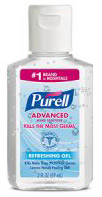
Aside #1: if you can’t get hand sanitizer, you can make your own if you can get 99% isopropyl alcohol; mix two parts alcohol with one part hand cream and blend it thoroughly. It’s probably not as good as the regular ones, but it’s better than nothing.
I get asked if ethanol (the alcohol you drink) would work, and the answer is probably, but to get the concentration you need, you better use pure grain alcohol or at least 150 proof. Methanol (wood alcohol) is rather toxic, and I’d stay away from it. But basically, all alcohol will work.
Chlorine Bleach
Standard laundry bleach is usually 2.6% to 5.25% sodium hypochlorate (bleach), which is WAY too high a concentration to use for disinfecting. To make a disinfectant, you want to add 20ml of 5.25% bleach to a liter of water. Double it to 40ml if you have 2.6% bleach, etc. 
Two important notes here: NEVER mix chlorine bleach with any other cleanser or put it into a bottle that used to have another cleanser without thoroughly rinsing the bottle. And mix it in a well-ventilated area just in case. Bleach plus ammonia, vinegar, and several other things can cause noxious fumes.
Chlorine bleach is very effective, hospitals use it, but it can be irritating in large quantities, and it can fade dyes and color. If you decide to spray down an entire room, for example, keep people out of that room until the fumes clear. It can also fade dyes and colors.
Non-Chlorine Bleach/Oxidizing Agents
Chemical names: hydrogen peroxide, sodium percarbonate, sodium perborate
Examples: Clorox II, Oxi Clean, etc. 
There are a lot of products in this category; basically oxy-this, non-bleach that, ‘safe bleach,’ and of course the dreaded ‘non-chemical’, ‘all-natural’, and I’m sure you can get it as organic and non-GMO bleach at slightly higher prices. They mostly are peroxides, like hydrogen peroxide, but often slightly different chemicals that are more stable; regular hydrogen peroxide tends to bubble off and lose effectiveness over time once it’s opened.
You need at least 2%, and probably 3% peroxide to be an effective disinfectant, and even then, its effectiveness against Coronavirus is ‘probable,’ but not guaranteed.
Quarternary Ammonium Products
Chemical names: benzalkonium chloride, Didecyldimethylammonium chloride, Benzethonium chloride
Examples: Clorox disinfecting wipes, Mediclean, Fantastik
There are tons of these. Benzalkonium Chloride is probably the one you see most commonly if you read ingredient labels, but if you’re interested in chemical names, just google it. They are both detergents (like soap) and disinfectants, so they’re very common in disinfecting wipes and such. They’re also what’s in most fabric softeners.
While I haven’t seen any actual studies regarding specific effectiveness against Covid-19, they are effective against other coronavirus and expected to be effective against this one.
Aside #2: Dryer antistatic sheets usually contain lots of quaternary ammonium compounds. My significant other (an ICU nurse) carries a few in her purse as door grabbers and emergency cleansing wipes.
Aside #3: Regular detergent can negate the detergent-like effect of quarternary ammoniums, so using both together isn’t better and in theory could be worse.
Thymol
The proper name is 2-isopropyl-5-methylphenol. I mention it mostly because you may have seen it marketed as your ‘all natural’, ‘non-chemical’, ‘essential oil’ disinfectant or preventative. It does work against some bacteria, but it’s useless against Coronavirus. There is some thymol in thyme essential oil, and I’ve seen some people selling that as protective against coronavirus. That’s just bullshit. (The editors wanted a more appropriate word here, but I couldn’t think of one.)
Triclosan
This is used in some ‘non-alcohol’ hand sanitizers and disinfectants. It’s pretty effective against bacteria but not against coronavirus, so if your hand sanitizer has this and doesn’t have 60% isopropyl alcohol, well, might as well stop using it.
Equipment and Spaces
Yeah, you already know about washing your hands and keeping your distance.
Studio and Office Space
The first word, doorknobs. This is the perfect place to use that dilute bleach solution, oh, 67 times a day if it’s a busy location. All surfaces, counters, desktops, should get this treatment too, but once or twice a day is probably enough in most cases. However, if you have a work location where different people may use the same desk or area during the day, it should get sprayed when person A leaves, and before person B starts there.
A few people have skin more sensitive to chlorine bleach than most, so a sign saying you’re using it is a polite thing to do. Alcohol will work instead of chlorine, but most of us aren’t able to get it in quantity, and it’s a lot more expensive.
Cloth things (backdrops, scenery, clothes) are best disinfected in a washing machine if possible. Regular wash with detergent is probably all you need, but a little bleach couldn’t hurt. If you can’t wash it, you can spray it with bleach solution or alcohol. Of course, bleach may fade dyes in cloth.
If you have non-chlorine bleach or quartenary ammonium cleaners or products, they will probably be effective and cause less ‘bleachy’ smell. Then again, right now, most of us welcome a bleachy smell. And ‘probably’ effective may not be what you want.
Camera Gear and Equipment
First, remember that if your gear has been sitting away from people for a couple of days, it’s safe. If you’re on a video production or multi-camera shoot, don’t share cameras. Assign who uses what equipment as much as is possible.
Alcohol and Soap
Despite what some manufacturers have said, we, and every repair shop I know have used isopropyl alcohol in 60% or greater concentrations on camera equipment for a long time and haven’t seen any adverse effects. Some manufacturers said 99% isopropyl might maybe affect lens coatings. I respectfully disagree, although I will say vigorous rubbing can affect some lens coatings, so take it easy and don’t use wire brushes or such.
Don’t soak it that is asking for trouble, just moisten it. Use common sense to try to keep your disinfectant on the outside and not put it on the inside. A light mist with a spray bottle, or a cloth or paper towel dipped in alcohol works great for large surfaces. You might want to dip a Q tip or similar thing to get into small areas or places where you’d rather not spray.
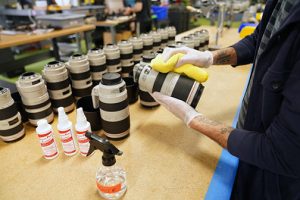 A little soap and water applied with a dipped cloth and rubbed can be used on appropriate places; lens barrels, camera rubber, light stands, etc. and wiped off with a cloth and water after half a minute. Spray alcohol may be better in nooks and crannies if you can find it. I recommend only to use Q-tips or a dipped cloth around camera viewfinders, etc.
A little soap and water applied with a dipped cloth and rubbed can be used on appropriate places; lens barrels, camera rubber, light stands, etc. and wiped off with a cloth and water after half a minute. Spray alcohol may be better in nooks and crannies if you can find it. I recommend only to use Q-tips or a dipped cloth around camera viewfinders, etc.
There is a chance that alcohol used repeatedly could dull the rubber of lens rings or camera bodies. I haven’t seen it, but I have seen it claimed. I have also heard that it can dull or fog the finish of LCD screens, but again I haven’t seen it, and I do know the ‘monitor cleaner’ I use contains isopropyl alcohol. Still, given the others who claim it can, at least in some cameras, I’d try to keep it to a minimum.
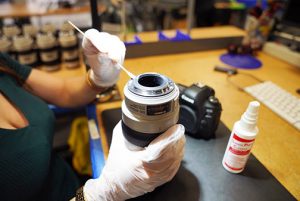 Either of these disinfectants can be used on light’s fresnel screens, but I would not apply them to high-intensity tungsten or strobe bulbs themselves. Any residue could, like finger oil, cause issues and burn out your bulb. They should be fine for LED lights, though.
Either of these disinfectants can be used on light’s fresnel screens, but I would not apply them to high-intensity tungsten or strobe bulbs themselves. Any residue could, like finger oil, cause issues and burn out your bulb. They should be fine for LED lights, though.
Problems: It’s very difficult to find isopropyl alcohol right now, so you may have to consider alternatives.
Dilute Chlorine Bleach
This should be fine on metal things like light stands or lens barrels. It’s probably fine on hard plastic, although there’s a slight chance it might fade colors. Same with cloth or rubber, although the color fading chance is higher. And it could cause some rusting on unpainted iron surfaces.
I would not use chlorine bleach on cameras, myself, nor would I apply it to front or rear elements. I think it would be safe, but I’m not certain, and I would go with one of the alternatives.
Non-Chlorine Bleaches/Oxidizers
These are less likely to cause fading, but you need to assume you’re in the ‘probably effective’ category now. I wouldn’t hesitate to use them if that’s what you have, though; probably effective is better than nothing.
Quarternary Ammonium Products
If you’re able to get a ‘disinfectant’ level product, I’d be as comfortable with using this as bleach as far as effectiveness, but it will have less chance of irritation, fumes, or fading colors. The CDC does say these are effective for disinfecting surfaces for coronavirus, but I have been unable to find clear data on how long of exposure is necessary.
One Last Note About Cameras
I think it’s pretty easy and pretty safe to disinfect all of your equipment and studio space or office effectively EXCEPT, for your camera. Let’s face it; you (or them) got your face all up in there, so it’s the most likely place to have received a big viral load. It’s also the place you DON’T want to soak and saturate with any of the above solutions. Plus, the areas around the LCD, viewfinder, etc. are full of nooks and crannies, making them more difficult to get to, and according to some manufacturers, LCD screens might be sensitive to disinfectants. (Again, my own opinion is I haven’t seen it, but what manufacturer’s say can’t just be ignored).
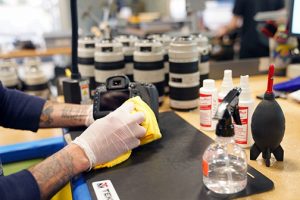 I’d recommend just not sharing cameras on a shoot, right now. If you do share, disinfect it carefully with a minimal solution and set it aside for 24 hours; 48 hours if you are paranoid. Virus particles don’t make spores and are not going to last on a surface for a long time. I, personally, am comfortable that 24 hours is long enough, but there is some good evidence that it takes 72 hours to be absolutely safe.
I’d recommend just not sharing cameras on a shoot, right now. If you do share, disinfect it carefully with a minimal solution and set it aside for 24 hours; 48 hours if you are paranoid. Virus particles don’t make spores and are not going to last on a surface for a long time. I, personally, am comfortable that 24 hours is long enough, but there is some good evidence that it takes 72 hours to be absolutely safe.
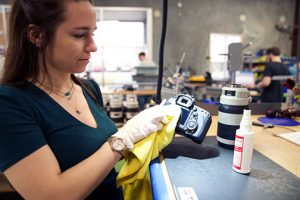 And while we’re talking about cameras, don’t forget that memory cards (and in some cases, like video shoots, batteries) get passed around a bit. They need to be disinfected when this happens.
And while we’re talking about cameras, don’t forget that memory cards (and in some cases, like video shoots, batteries) get passed around a bit. They need to be disinfected when this happens.
And a note about UV light
Far (not near) UV light kills bacteria fairly effectively and also kills some virus particles, but I do not know how effective it is against Coronavirus. But UV irradiation is generally used to disinfect air, in a location with limited airflow. It’s less effective on surfaces because it’s hard to get the light onto all the surfaces; and I can’t give you any numbers about how much exposure for how long is sufficient to disinfect a surface. (Truth is it will probably vary widely on different types of surfaces.) Right now, at least, UV just isn’t a practical answer.
About the Author

Roger Cicala is the founder of Lensrentals.com. Hailed as one of its optic nerds, he enjoys shooting collimated light through 30x microscope objectives in his spare time. When he does take real pictures, he likes using something different. He shoots with a medium-format camera or Pentax K1 DSLR, or a Sony Cyber-shot RX1R.




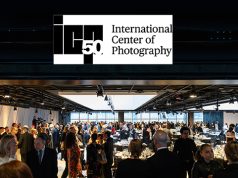

Roger, thank you for your insights. Since I am around my customers’ cameras all day long, I appreciate your tips on how to properly disinfect them. Hopefully, this whole situation will be behind us soon but we’ll all be better off practicing these cleaning tips in the future.